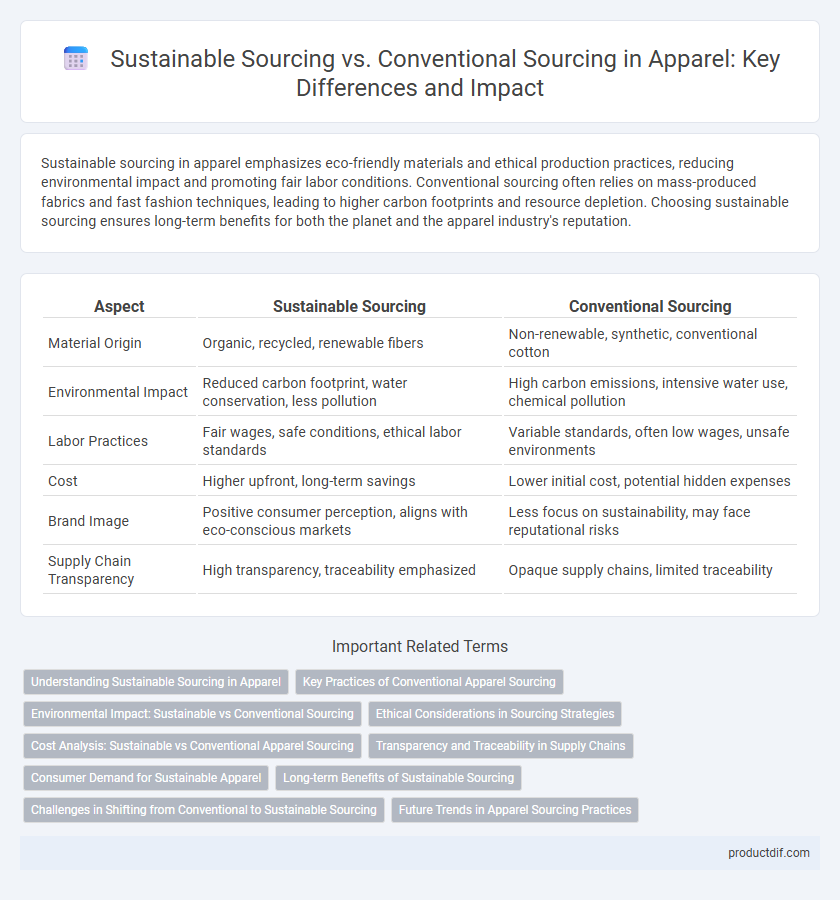Sustainable sourcing in apparel emphasizes eco-friendly materials and ethical production practices, reducing environmental impact and promoting fair labor conditions. Conventional sourcing often relies on mass-produced fabrics and fast fashion techniques, leading to higher carbon footprints and resource depletion. Choosing sustainable sourcing ensures long-term benefits for both the planet and the apparel industry's reputation.
Table of Comparison
| Aspect | Sustainable Sourcing | Conventional Sourcing |
|---|---|---|
| Material Origin | Organic, recycled, renewable fibers | Non-renewable, synthetic, conventional cotton |
| Environmental Impact | Reduced carbon footprint, water conservation, less pollution | High carbon emissions, intensive water use, chemical pollution |
| Labor Practices | Fair wages, safe conditions, ethical labor standards | Variable standards, often low wages, unsafe environments |
| Cost | Higher upfront, long-term savings | Lower initial cost, potential hidden expenses |
| Brand Image | Positive consumer perception, aligns with eco-conscious markets | Less focus on sustainability, may face reputational risks |
| Supply Chain Transparency | High transparency, traceability emphasized | Opaque supply chains, limited traceability |
Understanding Sustainable Sourcing in Apparel
Sustainable sourcing in apparel prioritizes environmentally friendly materials, ethical labor practices, and reduced carbon footprints, contrasting conventional sourcing which often relies on non-renewable resources and exploitative production methods. Brands adopting sustainable sourcing emphasize organic cotton, recycled fibers, and transparent supply chains to minimize ecological impact and improve social responsibility. This approach aligns with growing consumer demand for eco-conscious products and supports long-term industry resilience.
Key Practices of Conventional Apparel Sourcing
Conventional apparel sourcing primarily relies on large-scale procurement from established suppliers with a focus on cost efficiency and speed to market. Key practices include bulk purchasing, leveraging global supply chains for low-cost raw materials, and prioritizing supplier relationships that emphasize volume discounts and consistent quality. This approach often involves minimal emphasis on environmental impact or labor standards, contrasting sharply with sustainable sourcing strategies.
Environmental Impact: Sustainable vs Conventional Sourcing
Sustainable sourcing in apparel significantly reduces environmental impact by prioritizing organic materials, minimizing water consumption, and lowering carbon emissions compared to conventional sourcing. Conventional sourcing often relies on non-renewable resources, intensive chemical use, and practices that contribute to pollution and habitat destruction. The adoption of sustainable supply chains enhances biodiversity preservation and promotes long-term ecological balance in the fashion industry.
Ethical Considerations in Sourcing Strategies
Sustainable sourcing prioritizes ethical considerations by ensuring fair labor practices, reducing environmental impact, and promoting transparency throughout the supply chain. Conventional sourcing often overlooks these factors, potentially contributing to exploitative labor conditions and environmental degradation. Brands committed to ethical sourcing foster long-term social responsibility and consumer trust by integrating sustainability into their procurement strategies.
Cost Analysis: Sustainable vs Conventional Apparel Sourcing
Sustainable apparel sourcing often involves higher upfront costs due to the use of eco-friendly materials, ethical labor practices, and certifications like GOTS or Fair Trade, which can lead to increased production expenses compared to conventional sourcing. Conventional sourcing typically benefits from economies of scale and cheaper synthetic materials, reducing immediate costs but potentially incurring long-term savings losses related to environmental impact and brand reputation risk. Cost analysis must consider lifecycle expenses, where sustainable sourcing can offer value through reduced waste, improved consumer loyalty, and compliance with emerging regulations.
Transparency and Traceability in Supply Chains
Sustainable sourcing in apparel emphasizes transparency and traceability by providing clear, verifiable data on material origins, labor conditions, and environmental impacts, enabling brands to ensure ethical practices throughout their supply chains. Conventional sourcing often lacks this level of visibility, making it difficult to verify compliance with sustainability standards or identify potential risks in production processes. Enhanced traceability tools, such as blockchain and digital tracking, support sustainable sourcing by offering real-time insights that drive accountability and consumer trust.
Consumer Demand for Sustainable Apparel
Consumer demand for sustainable apparel is rapidly increasing as eco-conscious shoppers prioritize brands that use organic fibers, recycled materials, and ethical labor practices. Sustainable sourcing reduces environmental impact by minimizing water usage, chemical treatments, and carbon emissions compared to conventional sourcing, which relies heavily on resource-intensive cotton cultivation and synthetic fibers. Brands adopting transparent supply chains and certifications like GOTS and Fair Trade attract loyalty from millennials and Gen Z, driving market growth in sustainable apparel segments.
Long-term Benefits of Sustainable Sourcing
Sustainable sourcing in apparel reduces environmental impact by utilizing organic materials, water-efficient processes, and renewable energy, leading to enhanced brand reputation and consumer trust. It promotes supply chain transparency and worker welfare, which can increase supplier loyalty and reduce risks associated with regulatory compliance. Over time, sustainable sourcing drives cost savings through resource efficiency and positions companies for resilience in a market increasingly demanding ethical and eco-friendly products.
Challenges in Shifting from Conventional to Sustainable Sourcing
Shifting from conventional to sustainable sourcing in apparel involves challenges such as higher raw material costs, limited supplier availability, and complex supply chain transparency requirements. Brands must navigate fluctuating sustainable fiber yields and certification compliance, complicating inventory management and production timelines. Addressing these obstacles requires investment in supplier partnerships and advanced traceability technologies to ensure environmental and social accountability.
Future Trends in Apparel Sourcing Practices
Sustainable sourcing in apparel increasingly integrates eco-friendly materials, ethical labor standards, and transparent supply chains, responding to growing consumer demand for environmental and social responsibility. Conventional sourcing, reliant on fast, cost-driven production methods, faces pressure to adapt due to regulatory changes and evolving market expectations. Future trends emphasize circular economy models, advanced material recycling technologies, and digital traceability to enhance sustainability and reduce the industry's carbon footprint.
Sustainable sourcing vs Conventional sourcing Infographic

 productdif.com
productdif.com